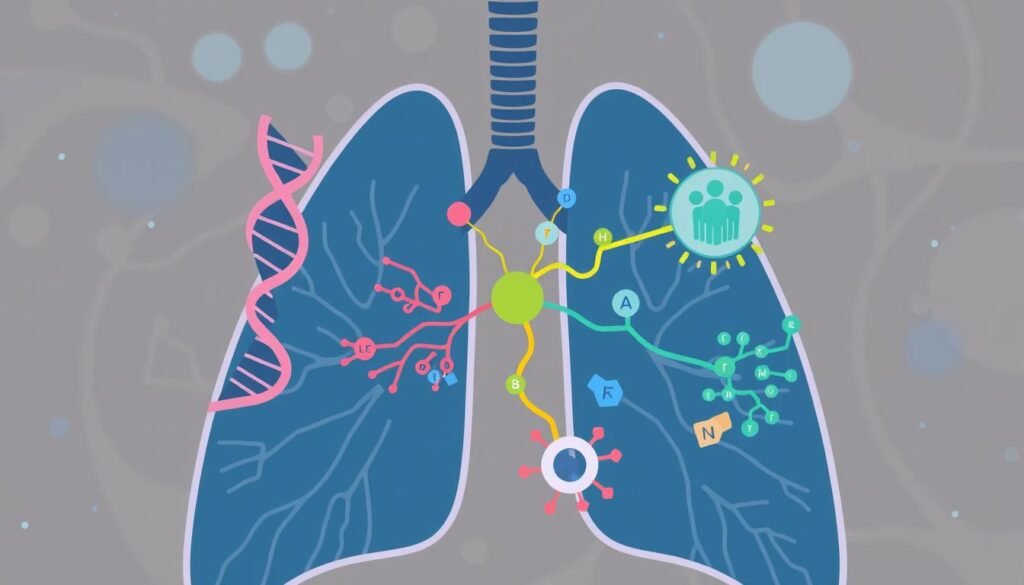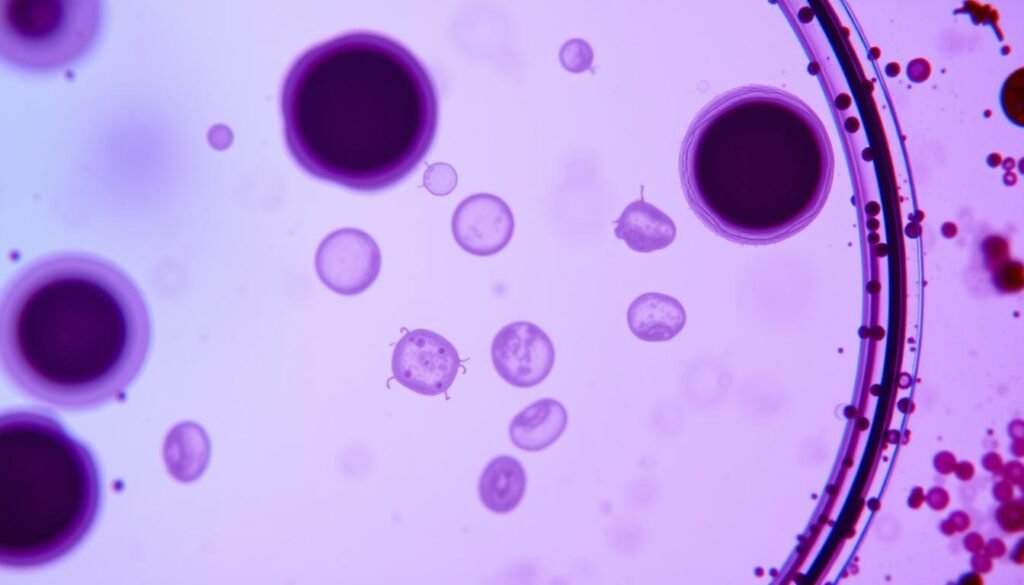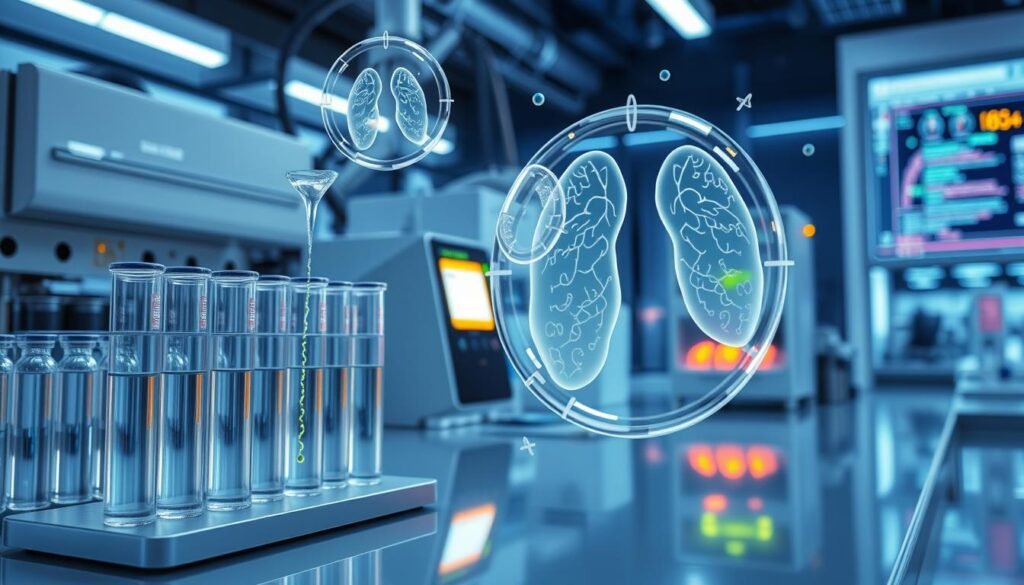Lung cancer leads to about one-third of all cancer deaths worldwide. This fact shows the urgent need for better ways to diagnose and treat it. Lately, there’s been a big focus on biomarkers. This has changed how we deal with lung cancer, making treatments more personalized. Knowing the different Types of Biomarkers for Lung Cancer can really improve how well treatments work and how long patients live.
Lung cancer biomarkers are key in creating customized treatments for patients. They cover molecular, protein, and epigenetic markers. These are looked at to understand the cancer better. By doing so, it helps not just in finding out if it’s lung cancer but also in picking the best treatment plan.
Clinicians use different biomarkers, like Molecular Biomarkers and Protein Biomarkers, to spot unique changes in genes or proteins. This guides them in making treatment plans meant just for you. This guide will explain the importance of these biomarkers, how they are tested, and how they affect the chances of getting better.
Key Takeaways
- Lung cancer ranks as the leading cause of cancer-related mortality in the U.S.
- Personalized treatment strategies are driven by various lung cancer biomarkers.
- Molecular and protein biomarkers offer critical insights for targeted therapies.
- Approximately 50% of non-small cell lung cancer (NSCLC) cases express PD-L1.
- Biomarker testing is essential for identifying specific treatment options.
- Understanding these biomarkers may lead to improved survival rates for patients.
- Research continues to explore innovative diagnostic and treatment strategies.
Introduction to Lung Cancer Biomarkers
Lung cancer is a major health challenge, with about 221,200 new cases in 2015. Lung Cancer Biomarkers are essential in bettering Lung Cancer Diagnosis and treatment methods. These biological indicators show the disease’s presence or its progression. They can be various substances, such as DNA mutations, or specific proteins in tumor cells. With Biomarker Testing, doctors can learn how severe the cancer is and predict how well treatments will work.
Biomarker testing has started a new phase of customized medicine in treating lung cancer. It helps figure out the cancer’s DNA mutations, leading to personalized treatment for non-small cell lung cancer (NSCLC) patients. But, people with small cell lung cancer (SCLC) don’t get this testing often since there aren’t any SCLC biomarker-based treatments approved by the FDA.
Over 20 driver mutations linked to NSCLC, like EGFR, ALK, and KRAS G12C, have been found. These discoveries help make targeted treatments that better help patients. Also, checking immunotherapy biomarkers, such as PD-L1 protein, helps decide who can get immunotherapy treatments. This is promising for patient care.
Work is being done to confirm biomarkers’ usefulness in clinical practice, which is key to using them widely. Biomarker Testing advances are boosting Lung Cancer Diagnosis and helping doctors choose better treatments. This improves care for patients. For more information on how biomarkers are transforming lung cancer care, explore this valuable resource.
Understanding Biomarkers in Cancer Treatment
Lung cancer is the top cause of cancer deaths in the United States. This fact highlights the need for effective Cancer Treatment methods. Biomarkers in Therapy are central to personalized medicine. They give important info on tumor actions. This lets doctors design treatments that target cancer cells while sparing healthy ones.
New tech, like next-generation sequencing (NGS), has transformed how we find biomarkers. These advancements let us spot mutations in lung cancer such as EGFR, KRAS, and ALK. Knowing these biomarkers helps plan treatments, especially for advanced lung cancer. They are also useful for early-stage cases.
For those with advanced cancer, doctors might suggest genomic biomarker tests. These tests have become common for many cancer types. They range from single biomarker tests to full genomic panels. This helps in creating personalized treatment plans.
Tests for programmed death-ligand 1 (PD-L1) can show if immunotherapy is right for lung cancer patients. The value of these tests spans many cancers, like breast and colorectal. This greatly affects each patient’s treatment approach.
Biomarker tests clarify which treatments might work best. They can show when some therapies might not be effective. They can also reveal inherited mutations that increase cancer risk. Biomarker testing’s role is expected to grow. This progress will push precision medicine and new therapy methods forward.
| Type of Biomarker | Associated Cancer | Technical Method |
|---|---|---|
| EGFR | Lung Cancer | Genomic Testing |
| Tumor Mutational Burden | Multiple Cancers | Whole-Exome Sequencing |
| PD-L1 | Lung Cancer | Protein Expression Testing |
| HER2 | Breast Cancer | Protein or Gene Status |
| KRAS | Colorectal Cancer | Molecular Testing |
Current research keeps showing how these biomarkers are key in fighting cancer. For those wanting to learn more, check out biomarkers in lung cancer treatment. This guide offers deep insight into this changing area.
Types of Biomarkers for Lung Cancer
It’s important to know about biomarkers for lung cancer to diagnose and treat it well. Biomarkers are split into three types: molecular, protein, and epigenetic. Each kind plays a part in finding out the particular traits of lung cancer. This information helps choose the best treatment.
Molecular Biomarkers
Molecular biomarkers find genetic changes linked to lung cancer. Mutations in important genes can lead to tumor growth. EGFR mutations are common in some groups and are key in planning treatment. Knowing these genetic changes helps doctors pick the right treatment, improving the patient’s chances.
Protein Biomarkers
Protein biomarkers look at specific proteins to spot or track lung cancer. PD-L1 is a protein biomarker important for a type of lung cancer called NSCLC. Finding these protein markers helps decide who might benefit from specific, more effective treatments.
Epigenetic Biomarkers
Epigenetic biomarkers are about changes that influence gene activity without altering the DNA itself. These changes can affect how lung cancer grows and responds to drugs. The study of epigenetic markers is becoming more crucial. It helps us understand lung cancer better and find new treatment options.
| Type of Biomarker | Description | Importance |
|---|---|---|
| Molecular Biomarkers | Genetic alterations, such as mutations. | Guides targeted treatments tailored to genetic profiles. |
| Protein Biomarkers | Specific proteins that indicate cancer presence. | Aids in determining eligibility for immunotherapies. |
| Epigenetic Biomarkers | Modifications affecting gene expression without DNA changes. | Offers insights into tumor behavior and treatment response. |
Common Molecular Biomarkers for Lung Cancer
Learning about common molecular biomarkers is key to improving lung cancer treatment. EGFR mutations, ALK rearrangements, and KRAS mutations play a big role. Each one impacts how patients are treated and cared for.
EGFR Mutations
EGFR mutations appear a lot in lung adenocarcinomas, changing how treatment works. Drugs like gefitinib are effective for tumors with these mutations. They are found in about 16% of cases, making them crucial in lung cancer care. Testing for EGFR mutations is a must to pick the right therapy and help patients.
ALK Rearrangements
ALK rearrangements create proteins that cause cancer cells to grow out of control. This leads to new treatment options like crizotinib. People with this biomarker get very targeted treatments, which helps them live longer. Knowing about this biomarker helps doctors find the best cancer treatment.
KRAS Mutations
KRAS mutations are common in lung cancer, especially in smokers, and are found in 28% of cases. This mutation means a harder-to-treat cancer. That’s why figuring out KRAS mutations is key for figuring out the risk and how to handle the disease. These mutations are complex and need careful study and monitoring.

| Biomarker | Prevalence | Targeted Therapy | Clinical Significance |
|---|---|---|---|
| EGFR Mutations | 16% | Gefitinib | Influences treatment decisions |
| ALK Rearrangements | Variable | Crizotinib | Targets oncogenic growth |
| KRAS Mutations | 28% | Limited targeted therapy | Indicates aggressive cancer |
Protein Biomarkers: Role in Lung Cancer Diagnosis
Protein biomarkers are key in lung cancer care, helping doctors tailor patient treatments. PD-L1 Expression and HER2 Overexpression are important. They guide therapy choices and affect patient results.
PD-L1 Expression
PD-L1 Expression is vital for choosing immunotherapy for lung cancer patients. High PD-L1 on tumor cells means a patient might do better. It shows they are more likely to respond well to treatments blocking PD-1/PD-L1. Testing for PD-L1 Expression with immunohistochemistry (IHC) at diagnosis helps pick the best treatment path.
HER2 Overexpression
HER2 Overexpression marks a tough lung cancer type. It shows high tumor growth and spread chances. HER2 is not just a marker but also hints at how well targeted treatments might work. Testing for HER2 Overexpression through IHC is critical for lung cancer patients, much like PD-L1.
| Biomarker | Type | Significance | Testing Method |
|---|---|---|---|
| PD-L1 Expression | Protein Biomarker | Indicates potential for immunotherapy response | IHC Testing |
| HER2 Overexpression | Protein Biomarker | Suggests aggressive cancer and therapy responsiveness | IHC Testing |
Doctors need to understand these protein biomarkers and testing methods well. It helps them make smart choices about lung cancer treatment. This could lead to better results for patients.
Circulating Tumor Cells and Their Significance
Circulating Tumor Cells (CTCs) are key markers in diagnosing lung cancer. They offer insights into the disease’s progression. CTCs show how much cancer is in the body and if it has spread. This information is vital for managing a patient’s care.
Many studies now show that CTCs vary in amount among different cancers. For non-small cell lung cancer (NSCLC), how often CTCs are found ranges from 19% to 50%, depending on the method used. Small cell lung cancer (SCLC) usually has a lot more CTCs because it grows faster.
There are several ways to separate CTCs from other cells. Techniques like ISET® and CellSearch© are proving effective, though not perfect. CTCs allow for detailed genetic testing. This can help tailor treatment to each patient.
| CTC Detection Method | Sensitivity | Typical CTC Count in NSCLC | Notes |
|---|---|---|---|
| CellSearch© | ~50% | 19% to 39% | Limited in certain patient groups |
| ISET® | ~80% in metastatic cases | 36% to 50% | Higher positivity in metastatic settings |
| Size-Dependent Techniques | Variable | Utilizes cell size for enrichment | Enables analysis of CTCs based on size |
CTCs are more than just signs of cancer. They hold clues about a tumor’s behavior, like its ability to spread. Although only a few can cause new tumors, watching CTC levels can guide care. This affects treatment choices and future cancer care plans.

Volatile Organic Compounds in Lung Cancer Detection
Lung cancer is a major cause of death worldwide, with about 1.59 million lives lost each year. Detecting lung cancer early is hard. Most cases are found at later stages. But finding it early can greatly boost survival rates. From 10% to 80%, survival jumps if found at stage 1. New methods are being discovered for early detection. One promising way uses the analysis of breath.
Potential of Breath Analysis
Breath analysis is a simple, non-invasive way to spot lung cancer early. Our breath holds over 500 kinds of VOCs. Some are there in extremely tiny amounts. Researchers have found certain VOC markers that could signal lung cancer. They’ve noted markers like benzaldehyde and 2-ethylhexanol.
This way of analysis can tell apart different lung cancers. It’s been accurate in studies, showing high success rates. A big review of 25 studies gave it high marks for precision. Thus, VOC analysis in breath is a trusted method for spotting cancer early.
Though there are hurdles like getting biopsy samples, breath analysis is a hopeful option. It helps doctors detect lung cancer better by spotting specific chemicals in breath. This easy test could change how we diagnose lung cancer. It might lead to better screening and early treatments.
Liquid Biopsy Biomarkers: A New Frontier
Liquid biopsy is a big step forward in cancer diagnosis. It uses body fluids like blood to find cancer markers. This process gives doctors a way to see what’s happening with a tumor without surgery.
Benefits of Liquid Biopsy
The Benefits of Liquid Biopsy are many. It’s way easier to collect a sample this way, which hurts less. Doctors can track changes in the cancer quickly. This helps them to change treatment if needed. A lot of research shows that scientists are excited about this. They’ve looked at over 47,000 studies. They believe it could help find cancer early by spotting signs in the blood.
Challenges and Considerations
But, there are big Challenges in Biomarker Testing. Finding tiny particles in blood, like exosomes, is tough. The tools we have don’t always work well. They can miss things or mix up samples. Cancer still takes too many lives. Finding a way to catch it early, using just a little bit of blood, is super important.
New tech and studies aim to fix these issues. They try to make tests better and more trustworthy for doctors to use. Liquid biopsy could really change how we find and treat cancer. But, we need to understand it better and solve these problems first.

| Aspect | Liquid Biopsy | Tissue Biopsy |
|---|---|---|
| Invasiveness | Minimally invasive | Invasive |
| Sample Collection | Blood or body fluids | Tissue sample |
| Detection of Biomarkers | ctDNA, CTCs, Exosomes | Molecular alterations |
| Real-Time Monitoring | Yes | No |
| Standard of Care | Emerging | Gold standard |
Future Directions in Lung Cancer Biomarker Research
The field of lung cancer research is rapidly changing. We are seeing exciting changes especially in the area of Biomarkers. Thanks to new technologies and a better grasp of tumors, we’re finding new ways to fight cancer. Researchers are working hard to improve how we diagnose and treat patients through Biomarker Innovation.
A new screening strategy that looks at the risk of emphysema is showing promise. It seems to work better than the old ways of finding lung cancer early. This could help us find high-risk patients sooner, leading to better care.
Checking that biomarkers really work is an important part of the process. We have to make sure they are exact and useful in real life. Good biomarkers must be reliable and sensitive, giving correct results no matter what.
To truly make these advances part of everyday care, teamwork is key. We need researchers, doctors, and companies to work together. By joining forces, they can turn scientific discoveries into real treatments that help more people. There’s a big effort to overcome issues like too many false alarms from tests, making sure our methods are the best they can be.
In the end, lung cancer biomarker research is not just getting a little better. It’s on the verge of making huge leaps. By working together, experts are paving the way for much brighter futures for patients.
Conclusion
Biomarkers are key in fighting lung cancer. They help with early detection and personalized treatments. This is important because lung cancer causes about 2 million deaths each year. Better screening can lower these numbers.
New technologies like liquid biopsies and LDCT scans are making a difference. For example, LDCT can lower death rates by 20% to 30% in some studies. Research on circulating tumor DNA (ctDNA) is also showing promise. It can help find tumors early.
Plasma metabolic profiling research is crucial. It’s helping us find new biomarkers and improve the ones we have. This leads to better diagnosis and treatments. In the end, biomarkers are shaping the future of cancer care. Supporting this research is vital.